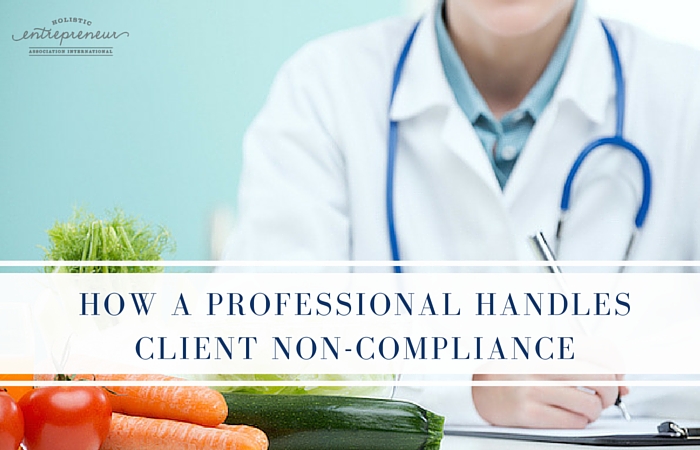 By David Peterson, Health and Wellness Practitioner Consultant
By David Peterson, Health and Wellness Practitioner Consultant
Many practitioners in the health care industry, and in particular when it comes to the holistic or natural health care solutions that they advise their patients or clients on, can struggle with what we call patient or client non-compliance. This is a term used concerning patients rejecting or doubting your recommendations. The reasons that patients do this are pretty specific and I fully cover it in a workshop where I show you a simple 5 step process to fully educate patients. Using this exact procedure will maximize patient compliance and will give you a much more rewarding practice where you really feel you are accomplishing the goals you originally set out to do when you first started.
The first area a lot of practitioners are weak on is fully understanding the patients’ thoughts or reality on their health, the subject of health in general and even of holistic or natural medicine. Very often patients come to you with a pre -conceived idea of what their problem is and what kind of treatment they need. You do the examination process and you find out something very different from what the patient is thinking about. How do you get these different realities to mesh? This is called presentation skills. There is a rule in presenting treatment. If a person has to make a decision or commitment to treatment or something that they are buying (yes, the patient is a consumer and this is a buying/selling situation), and if the thing they are deciding about is something they are NOT educated in, they will find the decision-making process STRESSFUL!! Somehow you need to bridge the gap between your knowledge and expertise on the subject and the patient’s limited understanding of the health situation and in fact the subject in general. If you can bridge that gap, reduce the patient’s stress on making a decision, you can get a lot more patients going ahead. And this means a lot less rejection. How do you do this? Let me explain…
Obviously, to get the patient up to your level of understanding, you would have to enroll them in a school program like the one you did to get trained! But of course, you are just presenting treatment here so your time has to be well spent. You don’t need to have patients with degrees to get them going ahead with your treatment. But you do have to raise their understanding enough so that they can make as stress-free a decision as possible. To do this you first have to fully understand and grasp exactly what is the patient’s limited reality and understanding of the subject. Many practitioners are weak on this point. Spending some time on it sets the foundation for a successful presentation. The first thing is to formulate questions you can ask to access the patient’s thoughts or understanding on things. Many offices have their set list of questions they ask patients to get some information. These can be questions like:
What brings you here today?
What symptoms are you experiencing?
How did you find out about our office?
And additional questions about the patient’s health history, etc….
While these type of questions have their role, they really just scratch the surface of the patient’s thinking process. You really need to get creative and dig in there to find out what the patient is really thinking about. Some of the things you WANT to find out about would be as follows:
What would motivate the patient to go that extra mile and put in the effort to do your health recommendations as opposed to procrastination or listening to another practitioners, etc..
How is the condition affecting their activities and lifestyle?
Many practitioners ask these type of questions. But that is still not enough. You want to find out…
What is really important about their life in their mind that this health situation might possibly affect negatively. This is a point of motivation. If the right motivation is found, your presentation will be more successful.
This line of questioning does not have to take a long time. And if you get good at it, it is done in minutes. It is usually done during the examination process and before you present any findings and recommendations.
But also there is the insidious false information syndrome. Most people in our society are infiltrated with this and you NEED to be alert to this as well when you are questioning the patient. A study showed that when people go on the internet looking for solutions particularly in the health arena, as much as 75 – 80 percent of the data they read can be false information. You run into this constantly. The patient says things like “my doctor recommended surgery” or “I’ll just go on-line and order my own supplements”, etc.. These kind of things go right into the teeth of your philosophy. It is too late at the end of your presentation to find out the patient has these thoughts. You should have questioned them on this type of thing earlier. The most common sources of false information that patients get exposed to come from friends, family, TV, the internet and even other practitioners with conflicting philosophies. In fact a lot of practitioners complain that they are competing with “Dr. Google” and complain about the false information patients get from internet searches. I have had practitioners show me another common source of incorrect data can even come from Wikipedia. People believe because the word ends in “pedia” that it is an online encyclopedia. But anybody can post things on there, so it’s far from foolproof. How do you deal with this false information? Well the first thing is to find out what exists in the patient’s mind and get all the information you can from them on it. Then once on the table where it is out in the open, then you can deal with it.
There is a rule in education. If a person is exposed to false information, especially as their first source of data on a subject, they tend to hold onto that false information and also have a tendency to reject future conflicting information. This can include the true education that you are trying to educate your patient or client on. The solution to this is to very subtly discredit the source of the false information, not the patient or client for believing in an incorrect source. First, you know the common areas of false information that your patients or clients come to your office with. You need to do your own research on this. Go and find creditable documents that back up your information (university studies, papers written by creditable organizations, etc.). Have a wealth of these printed and in your office to refer to with patients. When the patient comes up with the false information, you simply say “I understand where you are coming from. Let me show you some documentation from Harvard University,……” Then you show the documentation to back up your findings. What this does is it avoids the situation of “you vs the patient or client’s false information” or “you vs the patient or client’s opinion leader”. You get to remain the patient or client’s friend and you are just showing them some bonafide studies you have found. This can help greatly to dislodge or diffuse false information from stopping your patient or client from going ahead with your services.
In conclusion, here are the steps that you can use to help set up for a successful treatment plan presentation.
- Fully question the patient on all areas of their thought process with regard to the health condition (including how it affects their life, what is really important to them about it, and any false information they might have heard or read on it).
- Have your documentation ready to combat any of the common areas of false information patients or clients are exposed to, and use these liberally as needed.
- Now with a full understanding of the patient’s thought process and the areas of data he was thinking with, combined with the information from your examination procedure, you now formulate exactly how you will educate that particular patient or client on their situation (no cookie cutter approach).
I train health care professionals on a very effective 5 step procedure to thoroughly educate patients or clients. Experiment with the above points and have some fun with them. Then feel free to contact me with any questions you might have.
Also, you may take the free 15 minute business analysis on line at http://www.klmsoftware.com/analysis.php if you are interested in getting additional help with your practice. I can set up a free no obligation analysis of your practice’s strengths and weaknesses and offer any proposed solutions to any situations found.
Best of success,
David Peterson
www.davidpetersonconsulting.com
davidpetersonconsulting2@gmail.com
About the Author
David Peterson has been helping businesses expand their operations for the past 2 decades. For the past 15 years he worked as a consultant, coach and trainer for Canada’s largest healthcare practice management company helping practitioners in the health and wellness industries achieve their goals and dreams. David is now in private practice and takes on his own clients.





